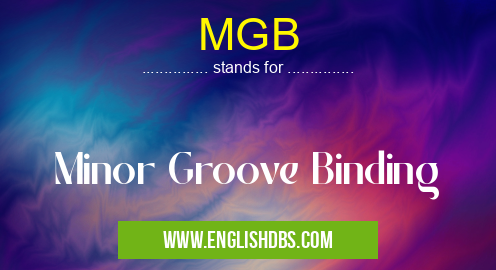What does MGB mean in UNCLASSIFIED
MGB stands for Minor Groove Binding. This term is used to refer to sequences of molecules that are able to bind to the minor groove of a DNA double helix. By binding to the minor groove, these molecules can influence and alter the way in which other processes, such as transcription and replication, carry out their functions. MGB molecules have become important tools for biochemists and gene-regulation researchers due to their ability to modulate the activity of underlying genes or pathways.

MGB meaning in Unclassified in Miscellaneous
MGB mostly used in an acronym Unclassified in Category Miscellaneous that means Minor Groove Binding
Shorthand: MGB,
Full Form: Minor Groove Binding
For more information of "Minor Groove Binding", see the section below.
Definition
MGB stands for Minor Groove Binding, which describes sequences of molecules that can bind specifically to the minor grooves in DNA double helices. MGB molecules work by recognizing specific base pair sequences within the DNA strands, allowing them to identify particular regions for binding. Through this binding process, these MGB molecules can modulate gene expression levels by changing mRNA stability or blocking transcription factors from accessing their target sites on DNA.
Application
The use of MGB molecules has become increasingly popular among biochemists and gene-regulation researchers due its potential uses in regulating gene expression levels. These MGBs can be used in several ways; they can be used as inhibitors or activators of transcription when combined with specific DNA-binding proteins, or they may be engineered into drugs that are designed to regulate specific biological processes and pathways within an organism. In addition, recent studies have shown that some MGBs may act as molecular switches, enabling scientists to ‘turn off’ or ‘turn on’ certain genes or genetic pathways at will.
Essential Questions and Answers on Minor Groove Binding in "MISCELLANEOUS»UNFILED"
What is Minor Groove Binding?
Minor Groove Binding (MGB) is a type of binding that occurs when molecules attach to the minor groove in a DNA double helix. This type of bond can form between DNA and other molecules, such as proteins or nucleotides, and has been found to play an important role in gene regulation.
How does Minor Groove Binding work?
MGB works by forming a specific type of bond with the minor groove of a DNA double helix. The bond is formed when the molecule's functional group binds to one strand of the DNA and the hydrophobic backbone is bound to the other strand of DNA. This type of bond can be used to regulate gene expression by controlling access to certain parts of the genome.
What advantages does Minor Groove Binding have over other binding methods?
One advantage that Minor Groove Binding offers over other methods is its specificity; because it binds directly to a specific region on the DNA, it can control access to only certain regions, which makes it ideal for regulating gene expression. Additionally, MGB has been found to be more stable than other types of binding, making it more reliable for long-term applications.
How is Minor Groove Binding used in research?
In research, MGB is used to study how different molecules interact with specific parts of the genome. It can also be used to understand how certain pathways are regulated at a molecular level and help researchers better understand diseases at this level as well.
Is Minor Groove Binding reversible?
Yes, Minor Groove Binding is reversible depending on the molecule being bound. Depending on its structure and properties, some molecules may remain attached even after being subjected to high temperatures or different chemicals while others may come loose much easier.
Where did scientists discover Minor Groove Binding?
Scientists first discovered Minor Groove Binding in 1983 in a study looking into how molecules interact with DNA strands specifically within its minor grooves. Since then scientists have done further research into this phenomenon and continue studying it today.
What types of molecules use MGB?
A variety of molecules use MGB when they interact with DNA strands including proteins, nucleotides, RNA fragments as well as small organic compounds like antibiotics or hormone receptor inhibitors.
How strong is the bond created by MGB?
The strength of the bond depends largely on what kind of molecule forms MGB; some bonds are much stronger than others but all should be considered relatively stable compared to other kinds of binding.
Final Words:
In summary, Minor Groove Binding (MGB) is a type of molecule that binds specifically to the minor grooves of a DNA double helix strand. These MGBs have become popular among biomedical research due its potential applications such as altering gene expression levels or acting as molecular switches during drug design processes. With further research and development, it is possible that we could see even more creative uses for MGBs within our own lifetime!
MGB also stands for: |
|
| All stands for MGB |
